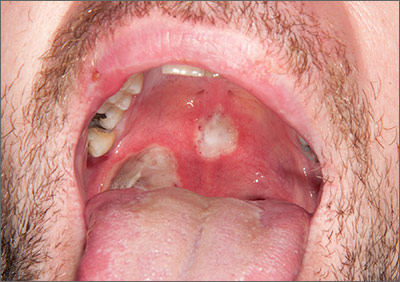The patient was diagnosed with Behçet’s disease (BD) based on his clinical presentation. BD is a rare multisystem inflammatory disorder of unknown cause. The development of ulceration at the site of superficial skin injury (pathergy) is typical of BD. (The patient underwent multiple venipunctures while being investigated for a presumed infective illness prior to this presentation.)
There are no diagnostic laboratory tests for BD; laboratory findings usually reflect systemic inflammation. The International Study Group for BD, however, has derived classification criteria for use in clinical research studies. Their criteria include oral ulceration (that has recurred at least 3 times in a 12-month period), plus 2 of the following: recurrent genital ulceration, eye lesions, cutaneous lesions, or a positive pathergy test.
Recurrent mouth ulcers frequently involve the soft palate and oropharynx. Genital ulceration is the second most common manifestation of BD and is present in 57% to 93% of patients. The scrotum is most commonly involved, although the shaft and glans penis may also be affected. Ocular involvement is also seen in 30% to 70% of patients and is more frequent and severe in men.
There is no curative treatment for BD. The goals of treatment are to prevent organ damage and alleviate symptoms. Mucocutaneous disease is treated with potent topical corticosteroids. Severe attacks are treated with oral corticosteroids—1 mg/kg of prednisolone. The drug is tapered and discontinued once the disease is under control. Colchicine or dapsone is also an option. In refractory cases, consider thalidomide (50 mg once a day) or azathioprine (1-3 mg/kg). An anti-tumor necrosis factor agent may also be considered.
In this case, the patient was prescribed prednisolone 60 mg once a day, but relapsed once he was weaned off of it. He was then given thalidomide 50 mg once a day for 4 months and the disease resolved completely. The thalidomide was then reduced to 50 mg 3 times a week for 4 weeks, and then stopped completely. Nearly 2 years later, the patient has remained disease free.
Adapted from: Aslam A, Chalmers R. Mucocutaneous ulceration in a previously healthy man. J Fam Pract . 2014;63:97-100.


